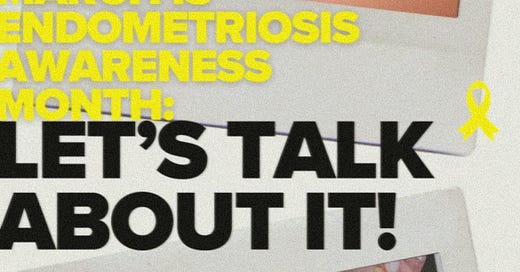March is Endometriosis Awareness Month—a time to educate, advocate, and support those affected by this often-misunderstood condition. Endometriosis impacts 1 in 10 people with a uterus, yet it remains underdiagnosed and widely misunderstood. Many endure years of pain before receiving the proper diagnosis and care.
Let’s dive into the facts, bust some myths, and discuss how we can all help spread awareness.
What is Endometriosis?
Endometriosis is a chronic inflammatory condition where tissue similar to the uterine lining grows outside the uterus. This can cause severe pain, organ adhesions, and other complications. The misplaced tissue responds to hormonal changes, leading to inflammation, scarring, and chronic pain—especially during menstruation.
It can affect areas such as:
Ovaries and fallopian tubes
The outer surface of the uterus
The bladder and intestines
In rare cases, even the lungs and diaphragm
Despite being one of the most common gynecological conditions, endometriosis is still widely under-researched and misdiagnosed.
Common Symptoms of Endometriosis
Symptoms can vary from person to person, but common signs include:
Severe menstrual cramps that don’t improve with over-the-counter pain medication
Chronic pelvic pain, even outside of menstruation
Pain during or after sex (dyspareunia)
Heavy or irregular periods
Gastrointestinal issues (bloating, nausea, IBS-like symptoms)
Fatigue that doesn’t seem to go away
Infertility or difficulty conceiving
It’s important to note that painful periods are not normal if they interfere with daily life. If you experience these symptoms, consider seeking a doctor specializing in endometriosis.
Misconceptions & Myths About Endometriosis
Unfortunately, many myths and misconceptions delay diagnosis and treatment. Let’s break down a few:
“It’s just a bad period.”
False. Endometriosis is a chronic inflammatory disease, not just period pain. It can cause pain at any time of the month.
“Pregnancy will cure endometriosis.”
False. Symptoms may temporarily improve due to hormonal changes, but the condition can return post-pregnancy.
“Hysterectomy is the only solution.”
False. While hysterectomy may help some individuals, it does not guarantee relief and is not a cure.
“If you’re not in pain, you don’t have it.”
False. Some people have silent endometriosis, only discovering it when facing fertility issues.
These myths contribute to a 7–10 year average delay in diagnosis. Raising awareness is key to changing that.
Getting Diagnosed: Why It Takes So Long
One of the biggest challenges in the endometriosis community is the delay in diagnosis. Why does it take so long?
Many doctors dismiss symptoms as “normal period pain.”
There is no simple blood test or scan to detect endometriosis.
Symptoms can overlap with other conditions like IBS or ovarian cysts.
The only definitive way to diagnose endometriosis is through laparoscopy, a minimally invasive surgery.
If you suspect you have endometriosis, advocate for yourself and seek out an endometriosis specialist.
Treatment & Management Options
There is currently no cure for endometriosis, but several treatment options can help manage symptoms:
Excision surgery: The most effective method for long-term symptom relief. It removes the disease rather than just burning the tissue.
Hormonal therapy: Birth control pills, IUDs, or GnRH agonists may help suppress symptoms.
Pain management: Includes anti-inflammatory medications, nerve blockers, and physical therapy.
Lifestyle changes: A balanced anti-inflammatory diet, regular movement, and pelvic therapy can support overall well-being.
Holistic approaches: Acupuncture, meditation, and heat therapy may help manage chronic pain.
Every case of endometriosis is different, so treatment plans should be tailored to the individual.
Why Endometriosis Awareness Matters
1 in 10 people with a uterus have endometriosis.
Many suffer for years without proper diagnosis or treatment.
Lack of awareness leads to misdiagnosis, unnecessary surgeries, and untreated pain.
By sharing stories, advocating for better healthcare, and supporting research, we can push for better diagnosis, treatment, and understanding.
How You Can Help
Even if you don’t have endometriosis, you can make a difference. Here’s how:
Listen & believe people who share their experiences with chronic pain.
Advocate for better women’s health education and research.
Share resources to help end misinformation.
Donate to research organizations supporting endometriosis awareness and treatments.
Every conversation counts in breaking the stigma around endometriosis.
Join the Conversation
If you or someone you love has endometriosis, share your experience in the comments below or on social media. Let’s raise awareness and support one another.






